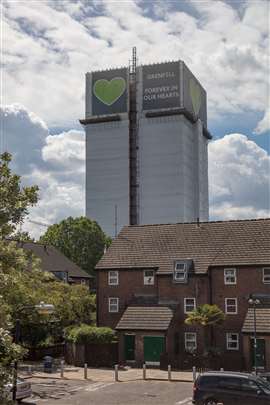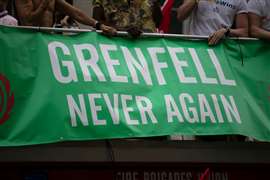What can be done to solve the global cladding crisis?
16 September 2024
The final report of the Grenfell Inquiry has highlighted the fact that millions of homes and offices around the world could be encased in combustible cladding and insulation panels. Lucy Barnard looks at how construction professionals and government officials around the world are working to prevent further disasters
Seven years after 72 people were killed in a devastating fire in the Grenfell Tower, West London, governments around the world are still struggling to respond to the threat of combustible cladding on tall buildings.
A UK public inquiry into the fire which published its final report earlier this month - and a spate of recent building fires - have highlighted the global issue of its use on potentially millions of homes and offices.
The Grenfell Inquiry found that panels made from an aluminium composite material (ACM) façade, containing plastic components, installed on the Grenfell Tower during a refurbishment between 2012 and 2016 was the principal reason for the fire’s rapid spread.
 The remains of the Grenfell Tower in West London. Photo: Adobe Stock
The remains of the Grenfell Tower in West London. Photo: Adobe Stock
Other major building fires whose spread has been linked to the use of ACM panels include: a 2010 blaze at a 28-storey high rise apartment building in Shanghai, China in which at least 58 people died; a fire at the 21-storey Lacrosse building in Melbourne, Australia; a spate of 18 fires on high-rise buildings over the last 13 years in Dubai; and a blaze at a 14-storey luxury residential apartment complex in Valencia, Spain earlier this year which killed ten people.
“Safety of people in the built environment depends principally on a combination of three primary elements – good design, the choice of suitable materials and sound methods of construction, each of which depend in a large measure on a fourth, the skill, knowledge and experience of those engaged in the construction industry,” said Grenfell Inquiry chair Sir Martin Moore-Bick. “Unfortunately, as our investigations have shown, at the time of the Grenfell Tower fire there were serious deficiencies in all four of those areas.”
The fires have prompted calls by Grenfell survivors and others for a global ban on combustible materials being used on all external wall systems.
But for construction professionals and governments around the world seeking to prevent a similar tragedy happening again, working out exactly which products to outlaw and under what circumstances, as well as establishing which existing buildings could be under threat, is proving to be a gargantuan task.
From the 1980s, a drive to cut heating costs and carbon emissions, encouraged architects and builders to encase structures in cheap and widely available insulating panel systems. With a mirrored surface of shiny aluminium, the insides of these aluminium composite (ACM) panels often included flammable plastics like polyethylene.
In his report, Sir Martin points out that even before the fire broke out, combustible cladding systems were already banned for use on tall buildings in some countries around the world including France and Germany (although there are still reports of combustible cladding panels being used on tall buildings in both countries).
Why isn’t there a global ban on combustible cladding systems?
Others, however, including the UK, Australia and Spain, took a different approach, based more on the functional requirements of each building and only took steps to ban flammable cladding and insulation panels from tall buildings following the disaster (see box).
With non-combustible panel systems looking pretty much the same from the outside as those which pose a threat, one of the major problems for building owners and public safety officials is establishing which of the thousands of buildings built before these law changes are still covered in panel systems which no longer meet safety standards.
As well as the potential fire risk, the issue has caused additional strain for flat owners who find themselves unable to sell or mortgage their properties. Tenants and freeholders argue over who should pay for the extensive and costly remedial work.
Guillermo Rein, a fire science professor at Imperial College London says that many countries have not even started identifying buildings which contain ACM cladding due to fears about the costs of remediation and worries about what the information could do to local housing markets.
 Protestors hold a ‘Grenfell Never Again’ banner. Photo: Adobe Stock
Protestors hold a ‘Grenfell Never Again’ banner. Photo: Adobe Stock
“The situation is complex but the worst that can happen is that nothing is done about it,” he says. “Flammable ACM buildings must be identified worldwide soon, with a sound plan to bring extra safety to them while meaningful recladding work is arranged.”
Going forward too, countries are having to work out how to ensure that those building or refurbishing future towers understand the true level of risk of the materials they choose.
Although panel manufacturers have always tested their products to ensure that they met fire-safety standards, the Grenfell Inquiry heard that “systematic dishonesty on the part of those who made and sold the rain screen cladding panels and insulation products,” meant that pre-Grenfell, the results were often obfuscated.
Moreover, under pre-Grenfell arrangements, fire safety engineers would typically not be consulted over the design and construction of a façade, with most signed off via desktop assessments.
“Although we recognise that some changes have been made to the regulatory system since that time, we remain troubled by the fact that there is still no fire testing regime that delivers relevant information and by the failure to recognise the need for the application of competent professional judgement,” Sir Martin said. “We think a comprehensive overhaul of the fire testing regime needs to be undertaken together with initiatives that will improve the number of fire engineers capable of carrying out complex assessments.”
How some governments around the world have responded to the combustible cladding threat (so far):
As the final Grenfell report highlights, deciding exactly which cladding panels constitute a fire risk, how to test them and what should be done about those panels already in use are issues which are being dealt with in various different ways.
UK
In 2018, the UK government banned the use of plastics, wood and products that include combustible materials such as aluminium composite panels from being used in the external wall systems used in residential buildings more than 18 meters tall. Instead, the only cladding materials allowed are those with a European classification of A1 or A2-s1, which includes materials such as metal, stone, or plasterboard.
In 2020 the ban was extended to residential buildings over 11 meters. And in 2022, further revisions were made to bring hotels, hostels and boarding houses within the scope of the ban and to prohibit the use of metal composite materials with a PE core from the external walls.
In 2019, the UK government allocated £200 million (US$262 million) to fix private tower blocks wrapped in combustible cladding. By 2021, it announced an additional £3.5 billion (US$4.6 billion) in funding to replace dangerous cladding on high rises and loans to fix similar problems in some low rise buildings.
According to the latest UK government figures, as of July 2024, there are 4,630 residential buildings 11 meters and over in height identified with unsafe cladding, with remediation work yet to start on half of them.
The UK government has so far pledged more than £3.5 billion (US$4.6 billion) in funding to replace dangerous cladding.
Following Dame Judith Hackitt’s review of building regulations and fire safety, published in the wake of the Grenfell disaster, the government also set up a Building Safety Regulator responsible for overseeing tall buildings.
Nonetheless, the final report points out that much more is still to be done.
Among the Grenfell Inquiry’s key recommendations is the proposal to set up a single regulator to oversee all aspects of fire safety in the construction industry in England and Wales which would be responsible for assessing and certifying whether products conformed with the requirements of legislation, statutory guidance and industry standards.
The report also proposes that the construction regulator should set up a licensing scheme for principal contractors looking to build or refurbish higher risk buildings and that it would be a statutory requirement for a registered fire engineer to submit a fire safety strategy as part of each planning application.
Australia
Victoria: In 2018, the Victoria government passed legislation giving ministers the power to prohibit the use of products considered to pose a high risk. The following year, it established Cladding Safe Victoria (CSV), a government body responsible for removing combustible cladding from apartment buildings and publicly owned buildings across the state. It also amended the state’s Building Act enabling the state to take legal action against building professionals involved in the installation of non-compliant cladding. A statewide cladding audit by CSV, published in 2023 identified a total of 1,588 buildings across the state with combustible cladding.
Queensland: One of the few states in Australia which operates a licensing scheme for fire engineers. Following Grenfell, the government of Queensland established a five-day CPD course for fire engineers covering materials use and fire safety strategies. It has also introduced courses for building surveyors, inspectors on the topic. The University of Queensland, has created a library of cladding materials containing information, including fire safety information, about building products. In 2019 the state passed legislation prohibiting the use of ACM panels with polyethylene cores of more than 30%.
New South Wales: In 2018 the state’s Fair Trade Commissioner prohibited the use of ACM panels with cores of more than 30% on certain buildings after the state passed new rules allowing this to happen. The state has also passed new laws strengthening the independence of building certifiers and has introduced a requirement that only accredited fire safety practitioners can carry out functions affecting fire safety.
UAE
Following a serious fire at the Marina Torch tower in Dubai in 2012, the UAE governments moved to prohibit cladding assemblies for mid rise and high-rise buildings that are not fire rated. They also require a fire-resistant spandrel in buildings over 15 meters, all façade contractors to be licensed by the Civil Defence Office and panels to be tested along the lines of USA and UK tests. In 2012, the country also established a group of fire safety experts, the House of Expertise, which advises the Civil Defence Authority on new building proposals.
USA
Although each US state has its own building laws, clients and contractors widely adopt an International Building Code published by commercial organisation the National Fire Protection Association (NFPA). This code requires stringent fire tests for buildings taller than 40 feet.




